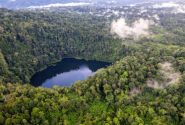
Identifying and counting different plants and animals found in tropical forests is nearly impossible to complete, say scientists. Raf Aerts
BOGOR, Indonesia (18 March, 2013)_Forcing timber, mining and plantation companies to carry out costly, time-consuming and for-the-most-part incomplete biodiversity surveys on their holdings could drive away those genuinely committed to conservation, while allowing less scrupulous commercial ventures to fly under the radar, a new study by the Center for International Forestry Research suggests.
“Listing species in an area is always a requirement,” says CIFOR researcher Erik Meijaard. “But it is not always practical and when over emphasized it becomes counter-productive.”
“You might find 400 species, or 5,000, but what does that really tell you?” he asked.
“And if you duly report the presence of an orangutan or another well-known and charismatic species that is either threatened or endangered, it can push back your operations by months, even years.”
“It’s a powerful disincentive to comply at all.”
Forest management guidance, such as the certification criteria of the Forest Stewardship Council, the Programme for the Endorsement of Forest Certification, and the Round Table for Sustainable Palm Oil, as well as good practices for mining and biodiversity by the International Council on Mining & Metals require the detection, identification, and management of endangered and nationally protected species.
Meijaard – biologist and co-author of The dilemma of green business in tropical forests: How to protect what it cannot identify published in Conservation Letters — has spent more than his share of time identifying and counting different plants and animals found in tropical forests, a task, he’s the first to admit, that’s nearly impossible to complete.
In the region of Borneo — divided largely between Indonesia and Malaysia, the top two producers globally of palm oil — for instance, it would take 500 taxonomists over 30 years to identify almost every species, of tree in a typical concession area, he said.
That’s simply not possible.
“For a palm oil or pulp and paper company to get involved in this is just not commercially viable,” said Meijaard, suggesting instead that companies be given realistic guidelines that would be straightforward to implement, such as easy guides to identifying carefully selected endangered species, simple methods for monitoring, and simple guides to identify key threats that might be neglected, such as invasive alien species.
Most importantly, all companies should maintain as much forest as is legally possible within their concessions, and ensure that no species are over-harvested. A species list is the wrong indicator to judge whether such management happened or not.
If you duly report the presence of a endangered well-known and charismatic species, it can push back operations by months. It’s a powerful disincentive to comply at all.
Meijaard’s stance is likely to draw controversy, with many in mainstream conservationists believing it could give timber, mining and plantation companies additional leeway to bulldoze plush, tropical forests that are home to hundreds of thousands of different species of flora and fauna, some found no where else in the world.
But Meijaard and his co-author, Douglas Sheil, argue that, if they want real conservation outcomes, it’s better to find practical ways to work collaboratively with these commercial entities.
Globally, the U.N. Food and Agriculture Organisation notes, 30% of the world’s forests are managed by timber, mining and other companies, four times greater than the forest designated for stricter conservation management, and it’s here that much of the biodiversity resides.
“Logging concessions have got to be a crucial part of forest management,” says Meijaard.
“Conservation NGOs may universally hate oil palm plantations, but if oil palm isn’t going to go away, what is the next option?”
“Many protected areas really are just pure paper parks – they exist in paperwork alone,” he says.
“What matters to me is the way an area is managed, not its status.”
Sheil and Meijaard have collaborated in the past to forward a related argument. In Purity and Prejudice: Deluding Ourselves About Biodiversity Conservation, published in the journal Biotropica in 2010, they argued that scientists need to be more consciously aware of their own judgmental biases which may predispose them against recognising practical and realistic conservation options that can be found in modified habitats, which they term the ‘tainted nature delusion’.
“As scientists we have to be aware of when we are thinking with our head and when with our heart,” Meijaard said.
“And we need to understand the tricks our mind can play on us,” says Sheil.
“Thinking in shades of grey and willingness to accept compromise are the basis of effective and sustainable conservation. We should not dismiss the value of modified ecosystems simply because we do not like them.”
For example, though most conservationists maintain that orangutans prefer “pristine” areas in protected forests, research has consistently indicated that the animals survive fairly well in modified landscapes: A recent CIFOR study suggests that nearly a third of all orangutans in the wild are found in logging concessions in Indonesia. If properly managed, these could be a realistic option for allowing sustainable development to take place in Southeast Asia, as well as a viable option for conserving the red apes in the wild.
“What we are ultimately arguing for,” Meijaard says, “is the potential for grey zones to generate benefits for both people and the environment.”
This work is part of the CGIAR Research Program on Forests, Trees and Agroforestry.
We want you to share Forests News content, which is licensed under Creative Commons Attribution-NonCommercial-ShareAlike 4.0 International (CC BY-NC-SA 4.0). This means you are free to redistribute our material for non-commercial purposes. All we ask is that you give Forests News appropriate credit and link to the original Forests News content, indicate if changes were made, and distribute your contributions under the same Creative Commons license. You must notify Forests News if you repost, reprint or reuse our materials by contacting forestsnews@cifor-icraf.org.










